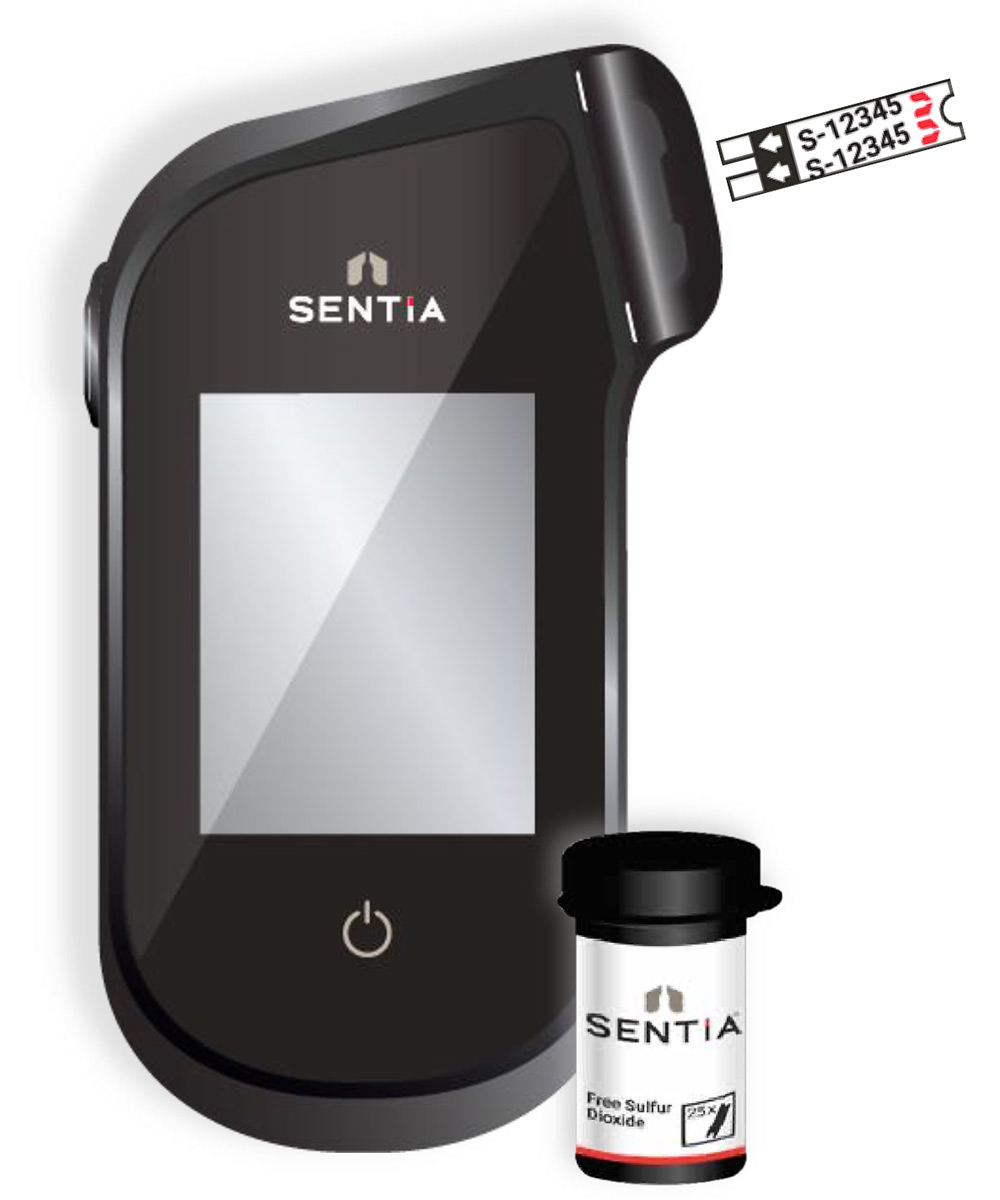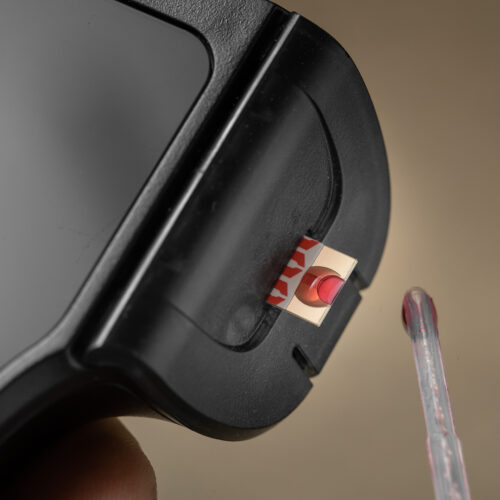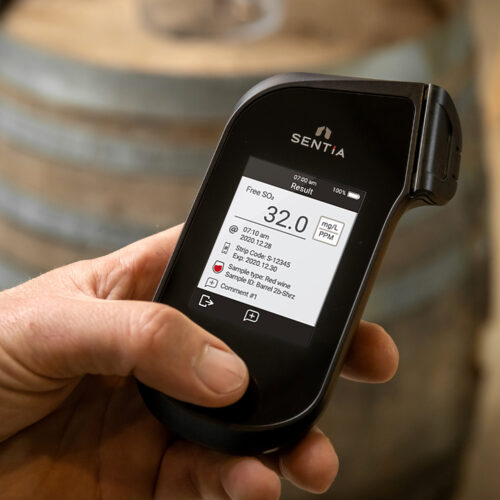Introducing the Sentia Wine Analyzer
PRODUCT FOCUS
Introducing the portable hand held Sentia Wine Analyzer

Sentia is a hand held, portable testing device which will change
the nature of laboratory testing in the wine industry
Sentia measures the concentration of free sulfur dioxide (free SO2) in post-fermentation wine. It is called free SO2 because we are only measuring the sulfur dioxide that has not bound with other chemicals in the wine (such as aldehydes, pigments, or sugars).
Sulfur dioxide is an additive used during the production of wine. In bottled wine, free SO2 acts as a preservative but there is a balance to strike: too much free SO2 can taint the consumer experience; too little could mean the wine spoils in the bottle. For this reason, measuring free SO2 is important to winemakers.
Malic Acid testing is now available with Glucose and Fructose testing coming soon!



Calibration and reagent free
There are no messy reagents because everything is packaged into the Sentia Test Strip. Calibration data is automatically and seamlessly transferred to the Analyzer by WiFi as each batch of Test Strips is manufactured at Universal Biosensors. This frees the user from messy and time consuming calibration.
Compatible with future test types
The same analyzer hardware will be able to test for other chemicals in the future.
(Note that this will require an in-field software upgrade which is downloaded automatically in the background over WiFi – but will need the user’s permission before installation takes place.).
Measuring range: 3 to 50 mg/L (free-SO2)
The measuring range is sufficient for the winemaker to make the required decisions with respect to free SO2.
Sample size: at least 8 microlitres
The small sample size makes sample application easier to and more reliable.
In-built quality control checks
The in-built quality control checks make the test results more reliable and less subject to external interference.
Stores up to 1000 test results for review- ing or exporting
The large database of historical results (which can be exported to other devices via WiFi) allows test data to be stored and analysed.
Light and portable with long battery life (up to 100 tests) and quick battery charging
The pocket-sized footprint (similar to a typical smartphone), light weight and long battery life (with quick charging time) makes Sentia a truly portable solution that provides quick and easy tests results wherever they are required.
7cm (2.8in) touchscreen colour display
The rich touchscreen display makes for an intuitive software experience that requires virtually no training or experience, allowing the user to focus on what really matters.
Wireless (WiFi) connectivity
The analyzer connects to WiFi to:
- download calibration data (done automatically and seamlessly in the background)
- export test results to external devices (like laptops, smartphones and tablets)
- download software updates automatically (software updates are only installed with the user’s permission)
SENTIA MEASUREMENT PERFORMANCE
Universal Biosensors has proven Sentia’s performance by doing specific studies at typical wineries as well as research institutes in the USA and Australia. A typical study involves statistical comparison between test results collected on Sentia and test results collected using a so-called reference method (which is one of several methods currently used by the industry). Reference methods are typically manual laboratory processes or benchtop chemical analyzers.
It is important to note that Sentia’s measurement performance has been proven with typical red wine and white wines. For other types of wine (e.g. sparkling wine, rosé and some light reds), results on the Sentia system may not match reference methods as well. In these cases, each user should start by cross- checking Sentia’s test results for their particular wine against an alternate method. Once Sentia’s performance has been characterised for their particular wine, users can determine free SO2 levels with confidence.
Frequently asked questions
Who should use Sentia?
Sentia is designed for winemakers that want to measure free sulphur dioxide concentration in post fermentation red and white wine.
What does Sentia measure?
Sentia currently measures free sulphur dioxide in post fermentation red and white wine. We are currently working on more tests including glucose, fructose and malic acid to name a few.
Where can I use Sentia?
Sentia is truly portable. It has the same form factor as a typical smartphone so it will even fit in your pocket. You can use Sentia wherever you need a test result.
Is sample preparation required?
No sample preparation is required. Simply apply a drop of post fermentation red or white wine to the Test Strip when prompted by the Sentia Analyzer.
How long does it take to get a measurement?
After you apply your wine sample, Sentia give you a result in under 1 minute.
Does Sentia store past results?
Yes. Sentia stores up to 1000 results in its memory and can export those results over WiFi.
Can I analyse my past results?
You can export your past results from Sentia over WiFi in CSV format (a test file format that is very easy to import into a spreadsheet). Once in a spreadsheet, it is easy to analyse, sort and filter your results.
Do I need to be connected to WiFi to get a result?
Sentia is able to run tests without a WiFi connection. You will need to have a WiFi connection when you first use Sentia so that we can download calibration data from the internet. After that, you will need to connect once every three months or so to download the latest calibration data for new strips made at our production facility. However, we recommend that you stay connected to WiFi as often as possible so that your software can upgraded when a new version is available.
Do I need to provide batteries?
Sentia contains a fully enclosed rechargeable battery and comes with a power adapter.
How long is the battery life?
Sentia can run up to 100 tests between battery charges. Charging the battery is as simple as plugging in the power adapter (provided).
